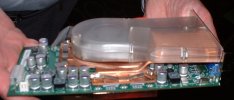
NVIDIA held the UK launch of GeForce FX at the Inter-Continental May Fair Hotel in London yesterday (18-Nov-2002). Here we were able to glean a few more details of what NVIDIA has in store for us with their latest high end product and managed to catch up with NVIDIA’s Geoff Ballew for a Q&A on some of the technical elements of GeForce FX. First lets go over some of the areas in the launch that wasn’t covered in our preview.
Although many expected the GeForce brand name to be dropped, GeForce is still a very strong brand and has plenty of recognition which is why it won’t be removed just yet. The inclusion of the ‘FX’ on the end was from two areas. First off, NVIDIA are touting this as “The Dawn of Cinematic Computing” so film Special Effects goes with the name. Secondly, this is the first design that the former 3dfx engineers have had serious input into an NVIDIA design, and so in some senses its homage to their input (not, of course, a way of leveraging more recognition from their strong brand name!).
Although one of the reasons for going to 0.13µ process technology is to lower the overall power usage of 0.13µ over parts based on older processes, NVIDIA decided to turn this on its head and instead of going lower power, they decided to use more power to get to higher clock speeds. As we mentioned in the preview its likely that a very high core clock speed will be sought, and this is indeed the case. NVIDIA are targeting a core clock speed of 500MHz. Whether all boards will see this is another question, it's highly probable that we’ll see a number of different SKU’s available with lower speed boards, and the highest end being 500MHz. The board images featured earlier in our preview showed the inclusion of a Molex power connector, and it's this that will allow enough power to get to the chip to facilitate such high clock speeds, as the AGP power supply would be insufficient.
NVIDIA state that these exceptionally high clock speeds are only facilitated by the use of the 0.13µ silicon process, with copper interconnects. 0.15µ processes that are frequently used at the moment do not utilize copper connects and thus this limits their overall clock speed potential. NVIDIA state that for this reason we are not likely to see 0.15µ parts above the low 300MHz points, however given that we’ve seen a number of R300 based parts hitting 400MHz, it may be that at least R300’s design has a little more headroom. Packaging is also another important element in reaching such speeds, which is why, like ATI’s R300, NV30 will utilize Flipchip style packaging.
Despite the newer, smaller 0.13µ process size, a 125 Million transistor chip running at 500MHz is going to need some effective cooling, and in this area NVIDIA appears to have gone to extreme measures. GeForce FX will feature a very large heat sink fan mechanism, with plenty of copper to channel the heat effectively. The solution will occupy both the AGP slot and the back panel and space of the first PCI slot because there is a fan / ducting system similar to that featured on ABIT OTES cooling system. The fan actually draws cool air in from the back, to cool down the copper heat sinks, and then expels the warm air out the back as well. Given that a high end, high price product such as GeForce FX is really aimed at the fringe, extreme gamer element NVIDIA feel that such a cooling system will not be a hindrance to its sales and, in fact, may actually aid it in such an area.
However, both the NV30 chip and cooling system does feature another useful element, which is that of ‘Silent Running’. Similar to the power regulation and clock speed altering systems found on portable graphics chips, GeForce FX will have hardware and software that can detect the activity and alter the running conditions accordingly. Elements such as chip heat, voltage and fan speed is constantly monitored so that when games are in use, and the full capabilities of the chip are being stretched, the cooling is at maximum operation. On the other hand, when doing low stress operations, such as 2D desktop operations, the core clock speed can be dropped, hence, so can the fan speed and the overall power consumption of the graphics system will be less. During these low speed operations the noise from the fan system should be greatly reduced, however in gaming obviously it will increase, but then it's not likely be as distracting in these situations. NVIDIA say that monitoring software will be provided and alerts will be available when elements of the chip or fan speeds are changed.
As for product shipping NVIDIA expects to have a small sample of production silicon ready in December, with volume product ramping in January 2002. Some board vendors I spoke with were hopeful that they could have products ready within a few weeks of them receiving chips.
Next, we managed to grab NVIDIA’s Geoff Ballew for a short while to discuss some of the elements of the GeForce FX architecture...


